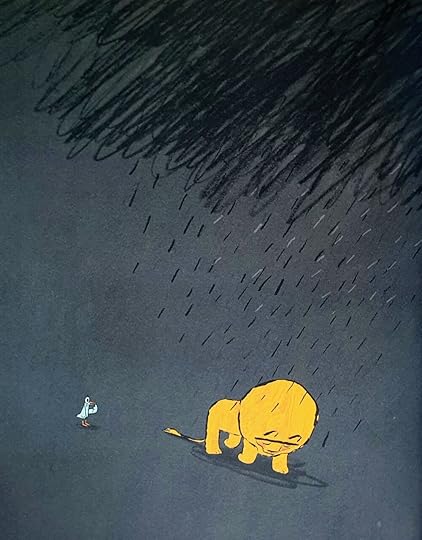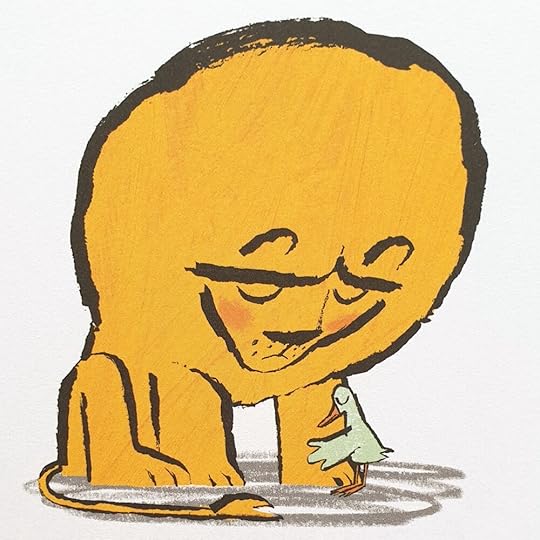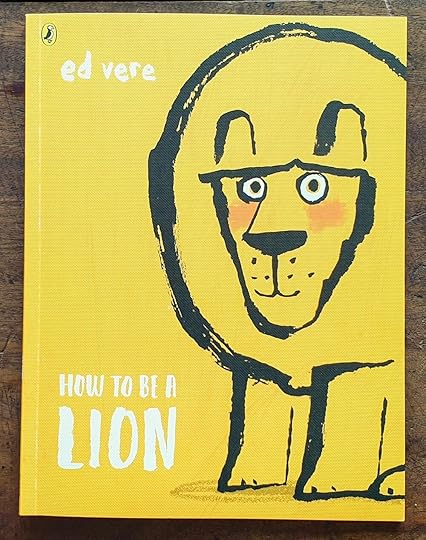How a gentle lion named Leonard will develop your child’s empathy

From How To Be A Lion by Ed Vere (Puffin, 2018) | Illustration © 2018 by Ed Vere
I have always been a bit of an outsider.As a kid, I was weedy and asthmatic (and way more interested in the birds on the sports field than the game around me). Quietly creative - a gentle bookworm who was easily intimidated. Most definitely an introvert who liked his own company. It’s only in recent years (thanks mainly to my therapist) that I have embraced my version of masculinity and learnt to celebrate myself! If only I’d grown up with this week’s Story Worth Sharing: How To Be A Lion by Ed Vere (Puffin, 2018).
How To Be A Lion poses the question: Can a lion be anything other than fierce? (Extrapolate that further, and the question is: Must I conform to preordained ideas?)
The star of the story is a gentle lion named Leonard.
Leonard loves to walk by himself, feeling the sun warm his back and the grass under his paws.
Leonard (as noted in Kirkus Reviews) ‘is aware that the general expectation of lions is to be fierce. [But] he opts not to live up to it. Instead, he…thinks up poems, and befriends Marianne, a duck.’

From How To Be A Lion by Ed Vere (Puffin, 2018) | Illustration © 2018 by Ed Vere
The story, notes BookTrust, ‘is warm and reassuring’. In part, that’s due to Vere’s friendly characterisation and use of a predominantly orange/red palette. I also agree with BookTrust that Vere’s writing, too, has a warmth reminiscent of Winnie-the-Pooh. (Like Pooh, Leonard has a thinking hill where he ‘thinks important thoughts’ and daydreams.)
Somewhere in between, he hums quietly and plays with words.
Putting them together
this way, then that way -
making them into poems.
(There’s a charming image of Leonard and Marianne, lying side by side, engrossed in their reading. (Look closely, and you’ll see Leonard’s book is Robert Frost’s The Road Not Taken, while Marianne reads Emily Dickinson.))

From How To Be A Lion by Ed Vere (Puffin, 2018) | Illustration © 2018 by Ed Vere
One day a pack of fierce lions came prowling around.
The archetypal big boys, the bullies: Those who are challenged by behaviour that they consider abnormal.
“What’s going on here?” they growled.
“Why hasn’t this duck been chomped?”
“This duck is Marianne,” said Leonard.
“She’s my friend and nobody will chomp her!”
I am still easily intimidated - so I feel for poor Leonard, who puts a protective paw around Marianne.
In Leonard, Vere presents an alternative male role model: ‘[A] strong-looking lion who thinks for himself, choosing creativity and friendship over superficial toughness.’ [Kirkus Reviews]
He’s a reminder that, sometimes, we must stick up for ourselves - and our friends. Even when pressured by those who are bigger (and fiercer) than ourselves.

From How To Be A Lion by Ed Vere (Puffin, 2018) | Illustration © 2018 by Ed Vere
Studies show that stories (including picture books for the very young) develop emotionally healthy children.How?
By modeling empathy - defined by WorldReader as ‘the ability to understand and experience the feelings of others, and to respond in helpful ways.’ Picture books like How To Be A Lion are essential for teaching this skill.
Vere’s expert storytelling will leave kids in no doubt about how Leonard feels. Just look at the heartbreaking image that follows Leonard’s interaction with the fierce lions. A heavy cloud – of despair, melancholy, and sadness – hangs over him in a wordless image that speaks volumes. To be fierce is not in Leonard’s nature. And he doesn’t want to change. Why should he? He’s happy being himself!

From How To Be A Lion by Ed Vere (Puffin, 2018) | Illustration © 2018 by Ed Vere

From How To Be A Lion by Ed Vere (Puffin, 2018) | Illustration © 2018 by Ed Vere
Thank goodness his friend, Marianne is at hand to support him.
Children need to develop empathy because it is central to living a successful life. Empathy leads to healthy, compassionate relationships. It helps children understand that we are all unique - and that difference is something to be celebrated.
In a nutshell: Empathy is good for both your child and society.
Leonard and Marianne need a plan. They sit together and think.
Ideas start to form.
They put their words together,
like this, like that, building them into a poem
that made sense of what they thought.
Finally, Leonard and Marianne confront the fierce lions. Bravely refusing to eat his friend, Leonard supports his decision with their poem, affirming their belief that no one way of being is true. In other words, Leonard finds the courage to be himself - a daydreaming, duck-loving poet!
Leonard concludes:
“If there must be a must, then this we must try…
Why don’t you, be you…
And I, will be I.”

From How To Be A Lion by Ed Vere (Puffin, 2018) | Illustration © 2018 by Ed Vere
One of the greatest gifts we can give children is the confidence to stand up for what they believe in and the courage to think for themselves.
To be brave (like Leonard) in the face of bullies. So, it may come as no surprise to learn that Vere wrote How To Be A Lion during the 2016 US election. His response (he says) to Trump’s bullish voice and narrow concept of masculinity. Vere expands on this in an article from The Guardian:
“Too often strength and sensitivity are presented as mutually exclusive… We need to teach compassion, respect and empathy at an early, foundational age. If we can teach this to boys at around five, and demonstrate that being gentle, sensitive or emotionally engaged isn’t a weakness, but part of being a fully rounded grown-up man, then we’re getting the message through to them before toxic attitudes have a chance to solidify.”
- Authors steer boys from toxic masculinity with gentler heroes (The Guardian)
Brilliant! A picture book that challenges traditional ideas of masculinity. ‘One that’, as Vere writes on his website, ‘doesn’t bully and belittle’.
‘Positive role models showing boys how to be a whole person are few and far between these days’, notes Kirkus Reviews. ‘This marvelous book triumphs in that essential job.’
And a triumph it is! Look closely in the background of the final spread, and you’ll see that at least one of the fierce lions has taken Leonard’s message on board - and has his nose in a book!
STORIES WORTH SHARING: How To Be a Lion by Ed VereGood to Read because:
It will develop your child’s empathy.
It challenges what it means to be masculine by presenting an alternative male role model in Leonard.
It celebrates being an individual - thinking for yourself and standing up for who you are.
(Use the book to spark conversation with your child: What makes them unique?)
GOOD TO READ
Picture books celebrating the individual
Only You Can Be You! by Nathan Clarkson, Sally Clarkson and Tim Warnes
Julian is a Mermaid by Jessica Love
Mr Big by Ed Vere
Boris Starts School by Carrie Weston and Tim Warnes
BUY THE BOOKPowered by Bookshop.org
Supporting independent bookshops

From How To Be A Lion by Ed Vere (Puffin, 2018) | Illustration © 2018 by Ed Vere
‘A philosophical tale so, so full of heart, celebrating the quietest and gentlest among us.’
- Library Mice‘Children will feel empowered’
- School Library Journal Buy UK Buy US* I EARN COMMISSION FROM THESE LINKS #AD/AFFdon’t forget – you can always borrow my recommendations from your public library! SOURCESHow To Be A Lion by Ed Vere (Puffin, 2018) Kirkus Review: How To Be A Lion BookTrust review: How To Be A Lion https://www.booktrust.org.uk/book/h/how-to-be-a-lion/ 7 Books That Inspire Empathy in Children by Selena Garrahan (WorldReader.org)Ed Vere on instagram Authors steer boys from toxic masculinity with gentler heroes by Donna Ferguson (The Guardian, July 14, 2018)Ed Vere’s websiteTime for Storytime: Ed Vere reads How to be a Lion (BookTrust on YouTube)Related articlesMax at Night: A perfect bedtime readFrom boys to men: how picture books can shape the futureTeaching empathy through picture booksPretty in pink© 2021 BY TIM WARNES(UNLESS OTHERWISE ATTRIBUTED)****USE OF THIRD PARTY COPYRIGHTED MATERIAL FALLS UNDER FAIR USE/FAIR DEALING PRACTICE.My Life in Books
For lovers of kid lit, this memoir - My Life in Books - is intended to give you the confidence and encouragement to share your own passion; to help you make lasting connections through kids’ books.
Originally posted at www.timwarnes.com ...more
- Tim Warnes's profile
- 30 followers



